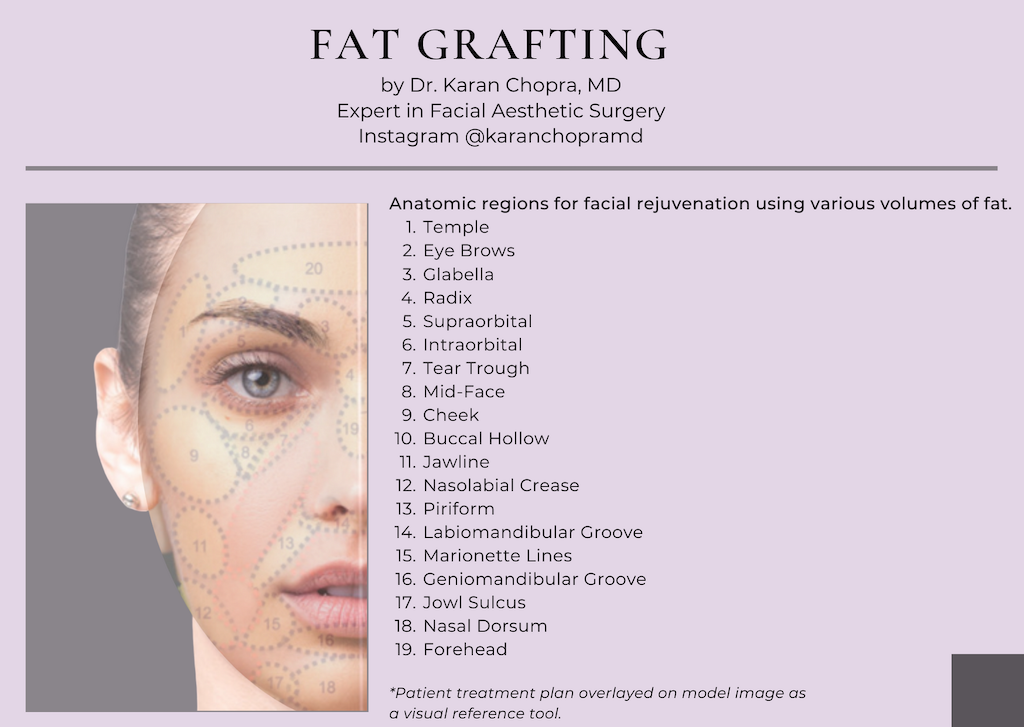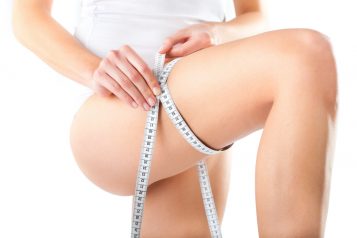Dr. Karan Chopra has co-authored over 50 peer-reviewed articles and book chapters in highly regarded medical journals including Plastic and Reconstructive Surgery®, the official Journal of the American Society of Plastic Surgeons and has presented research at several national plastic surgery conferences throughout the United States. Awarded the Johns Hopkins Miller Coulson Award for Clinical Excellence, Dr. Chopra has mastered communication and interpersonal skills and is known for his exceptional patient care. Approaching each patient with individualized care, he’s known for his genuine kindness and unparalleled bedside manner. His commitment to excellence in cosmetic surgery of the face, eyes, breast, and body has led to his mastery of the facelift, eyelid lift, breast surgery, tummy tuck, fat grafting, and injectables such as Botox, dermal fillers, and more. Haute Beauty sits down with Dr. Chopra to discuss fat grafting as an advanced surgical technique that leaves you rejuvenated.
 Photo Credit: Shutterstock
Photo Credit: Shutterstock
HB: What is fat grafting?
Fat grafting is an advanced surgical technique in which fat is harvested from a donor site on the patient’s body, such as belly or thighs, through liposuction, and then transferred into a new area. The latest innovation in plastic surgery is using fat grafting to address facial volume loss, the missing link in providing patients with longer-lasting aesthetic enhancements.
Depending on the application, a skilled surgeon can use fat transfer for face and breast procedures. In facial procedures, a fat transfer can be used to highlight specific features, such as lips or cheeks; or utilized as an overall strategy for Facial Rejuvenation. In breast surgery, breast augmentation with a smaller implant can be combined with fat grafting – a technique referred to as composite breast augmentation.
HB: Who is a good candidate?
Dr. Karan Chopra, MD. is a Johns Hopkins trained plastic surgeon, and he often recommends facial rejuvenation with fat grafting to address the signs of aging, over dermal fillers. Due to the unavoidable consequences of aging, fat loss leaves the face with a hollowed, sunken appearance. Fat grafting provides patients with a more permanent and natural look that restores their own youthful appearance. Dr. Chopra has seen first-hand how surgical procedures can have life-changing effects on patients’ lives. “During consultations, I am looking to understand my patients’ desired results to recommend the best possible outcomes.”
HB: How does fat grafting compare to dermal fillers?
While synthetic fillers like JUVÉDERM® and Restylane® are a quick-fix and readily available, the continuous maintenance can become expensive over the years, potentially exceeding the cost of a more permanent surgical procedure. Many patients seek “off-the-shelf” dermal fillers to quickly build volume in targeted areas.
Dr. Chopra notices a growing trend in nurses administering fillers without facial surgical training and aesthetic expertise, which may create an overly dramatic look that is easy to identify. Facial Rejuvenation with fat grafting yields results that are more refined than injectable dermal fillers and requires a highly skilled surgeon who is more a sculptor than a tailor. The combination of fat harvest and injection placement demands tact, surgeons need expertise with an artful eye and hand, which influence results.
What is so unique to Dr. Karan Chopra’s Facial Rejuvenation approach is using advanced technology to create a personalized 3D map to pre-plan targeted treatment areas. Most importantly, patients see superior results in their skin quality and texture that cannot be achieved through synthetic injectables. Using a patient’s own body fat yields a natural-filler that is rich in adipose-derived stem cells. These cells are believed to possess the capacity for self-renewal and continue to enrich patients’ facial volume post-operation. In younger patients who are not quite ready for a facelift, Dr. Karan Chopra recommends facial rejuvenation with fat grafting as an alternative to a more intensive and invasive facelift, or it can also be used in conjunction with a facelift depending on the patient’s vision.
 Photo Credit: Dr. Karan Chopra
Photo Credit: Dr. Karan Chopra
To counteract these facial responses, fat is injected into the targeted areas to subtly sculpt the temples, forehead, brow, glabella, radix, upper and lower eyelids, cheeks, mid-face, buccal recess, lips, peri-oral, nasolabial crease, geniomandibular groove, and jawline. Post-procedure, patients look revitalized; women appear soft, healthy, sensual and men regain their suave contours.
Procedure expectations
The procedure begins with harvesting fat from a donor area, it is then purified and processed into “nano fat.” This outpatient procedure occurs immediately before the nano fat is injected and is used to contour the target areas. Using a patient’s own fat sidesteps potential allergic reactions and allows for two areas of the body to be treated at one time. Patient discomfort is minimized through anesthetic sedation or with local anesthesia.
Fat grafting requires an insightful strategy to address overall enhancement. Very tiny incisions are made in the targeted areas and injections are made at separate sites. Then, a micro amount of fat is administered using numerous (20 – 40) back-and-forth movements until the entire 1-cc syringe of processed fat is criss-crossed, feathered, and placed accordingly for a seamless result. Detailed placement is critical, as it provides each molecule of fat a chance to fuse with living tissue, giving it the best chance to survive.
Post Procedure
Depending on the overall procedure, patients should rest but may be able to perform light activity within two days and return to work within the week. Swelling and discomfort is expected over the first few days and is managed with medication. Strenuous activity and exercise can resume after two weeks. As with all procedures, Dr. Chopra will request follow-up visits at key milestones to monitor healing progress.
Maintenance
While fat grafting is a more permanent solution, the harvested fat is autologous and there is a chance that 30-50% of the fat can be absorbed within the first six months. Patients may seek a touch-up after their procedure is performed.
If you’re interested in working with Dr. Karan Chopra, contact him directly at Gryskiewicz Twin Cities Cosmetic Surgery [https://www.tcplasticsurgery.com/] in Edina, MN at 952-842-1000 or in Burnsville, MN at 952-435-0177. Follow Dr. Chopra on Instagram @karanchopramd
For more information, visit Dr. Brian A. Levine's social media:

























